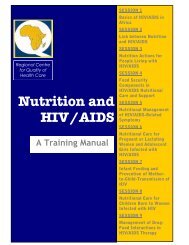Final Report - Linkages Project
Final Report - Linkages Project
Final Report - Linkages Project
You also want an ePaper? Increase the reach of your titles
YUMPU automatically turns print PDFs into web optimized ePapers that Google loves.
%<br />
100<br />
80<br />
60<br />
40<br />
20<br />
0<br />
Percent of children 6-23 months old eating various food groups<br />
(24-hour recall) - (P-values shown for comparison between RAP 2004 and RAP 2005)<br />
97 979597<br />
5 4 3 6<br />
26242723<br />
Grains/Tubers Eggs Legumes Vit A rich<br />
fruts &<br />
vegetables<br />
66 68<br />
505354 4952<br />
39<br />
Other fruits &<br />
vegetables***<br />
27 30<br />
1518<br />
Dairy***<br />
59<br />
49<br />
39 42<br />
75<br />
52<br />
5962<br />
Other animalFoods cooked<br />
source w / fats/oil**<br />
food***<br />
RAP 11/04 RAP 11/05 OD EL PD EL<br />
%<br />
50<br />
40<br />
30<br />
20<br />
10<br />
0<br />
Percent of children 6-23 months old eating various animal source foods<br />
(24-hour recall) - (P-values shown for comparison between RAP 2004 and RAP 2005)<br />
34<br />
30<br />
27<br />
23 25<br />
18<br />
15<br />
17<br />
2<br />
4<br />
3<br />
4<br />
14<br />
28<br />
24 24<br />
5<br />
4<br />
3<br />
6<br />
1 1 1 2 1 1 1 1<br />
Dairy*** Meat Poultry Fish/shellfish*** Eggs Organ meats Insects/small<br />
animals<br />
RAP 11/04 RAP 11/05 OD EL PD EL<br />
Conclusions:<br />
• For both the end-line and RAP samples, of the mothers surveyed almost half feed their children animal source<br />
foods and foods rich in Vitamin A and more than half use fats/oils to enrich the meals. These values are higher<br />
than those observed in the DHS 2003-04, which found only 27% of children reported to be eating animal source<br />
foods (including eggs) and only 30% eating fats/oil.<br />
• There were also signs of improvements in dietary diversity, particularly for the specific food groups promoted by<br />
LINKAGES. Data from the RAP04 and the RAP 05 showed that these improvements included more children<br />
eating fruits/vegetables, foods cooked in oil/fats as well as fish/shellfish. Inexplicably there seems to be a<br />
significant drop in the consumption of dairy products in these same samples of children; however, this is the<br />
same level, 16%, as that found in the DHS2003-04.<br />
• It should also be noted that additional analysis showed that the majority of children who received at least one<br />
animal source food in fact were eating more than one animal source food in the preceding 24 hours.<br />
• The PD EL sample shows the best values for dietary diversity across all but one of the food groups. Based on<br />
available data, which is limited, this difference cannot be explained in terms of effects of the project’s activities<br />
versus effects of different characteristics of the PD EL group versus the OD EL group and the RAP samples.<br />
Further analysis shows that none of the seemingly obvious environmental and socio-economic variables fully<br />
account for the high value of the indicators for the PD EL sample. Access to daily markets appears to makes a<br />
difference, rural vs. urban makes a difference, and food insecurity makes a difference. However, when all of<br />
these and other variables are controlled for, there is still a significant difference between the PD EL sample and<br />
the other groups.<br />
28

















